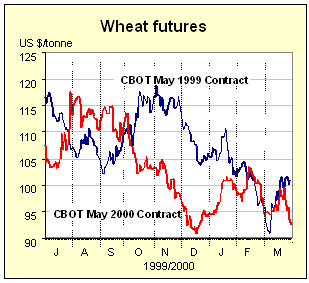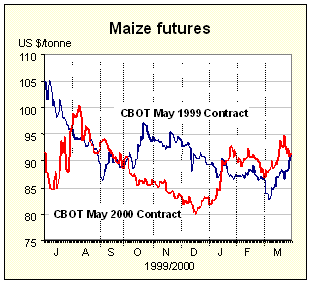


International wheat prices rose slightly since the previous report reflecting active trading and concern over adversely dry conditions for the United States wheat crop. The price of US wheat No. 2 (HRW, fob) averaged US$112 per tonne in March, some US$1 per tonne above January, although still some US$16 per tonne below March 1999. The price of Argentine Trigo Pan also averaged higher in March, at about US$98 tonne (fob), up some US$5 per tonne from January, but US$14 per tonne below the corresponding period last year.


However, the prospects for a stronger upturn in prices are limited given the generally good production prospects and relatively large carryover stocks in major exporting countries. In fact, in the futures market (Table A.8), while in recent weeks the soft red winter wheat May values in the Chicago Board of Trade, rose closer to last year's levels, mostly in response to worries over growing conditions in the United States, the small recovery was short-lived once weather conditions improved.
| 2000 | 1999 | ||
| March | Jan. | March | |
| (. . . . . . US$/tonne . . . . . .) | |||
| United States | |||
| Wheat 1/ | 112 | 111 | 128 |
| Maize | 95 | 93 | 97 |
| Sorghum | 95 | 91 | 92 |
| Argentina 2/ | |||
| Wheat | 98 | 93 | 112 |
| Maize | 85 | 93 | 92 |
| Thailand 2/ | |||
| Rice white 3/ | 234 | 244 | 262 |
| Rice, broken 4/ | 152 | 159 | 198 |
In the maize market, rising import demand, and concern over continuing dry conditions in several major producing areas of the United States, where the 2000 crop is due to be sown soon, led to sudden price increases in March. Nevertheless, against the background of generally ample availabilities in major exporting countries and continued large export supplies in China, the overall increase remained limited. In March, the US maize export prices averaged US$95 per tonne, up US$2 per tonne from January but US$2 per tonne below the corresponding period last year. Similarly, in Chicago, the May futures rallied during March, moving closer to last year's levels. Nevertheless, given the overall favourable crop prospects for 2000, it is difficult, at this early stage, to expect any sustained recovery in prices.

With the arrival of new rice crops onto the market in some major exporting countries, and continued dull import demand, international rice prices declined further in recent weeks. The FAO Export Price Index for Rice (1982-84 =100) averaged 103 points in March, down by 3 points from the previous month, and its lowest level since June 1994. In comparison, the Index stood at 116 points at the same time in 1999 and averaged 114 points for the whole of 1999.
In the United States, the market has been generally quiet with little activity and some prices have dropped from the previous month. Prices for high quality No. 2/4 percent broken rice averaged US$272 per tonne in March, down by US$3 per tonne from February. Supplies in the United States are at a record level, and, given the weak global import demand, prices may need to go down further to entice prospective buyers.